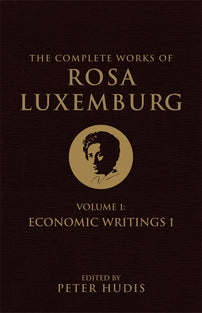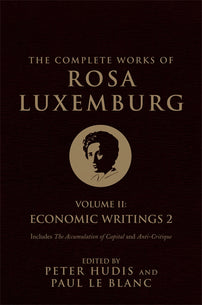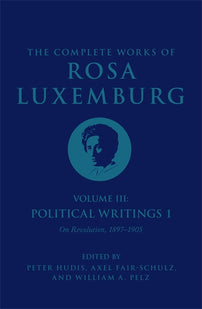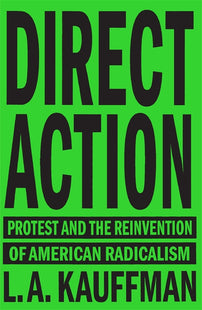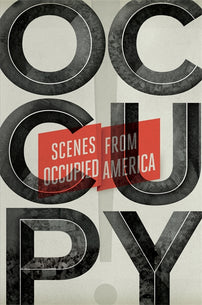Politics in the Streets
While the revival of reformist social democracy is cause for optimism, it cannot win a new world without mass pressure from below.
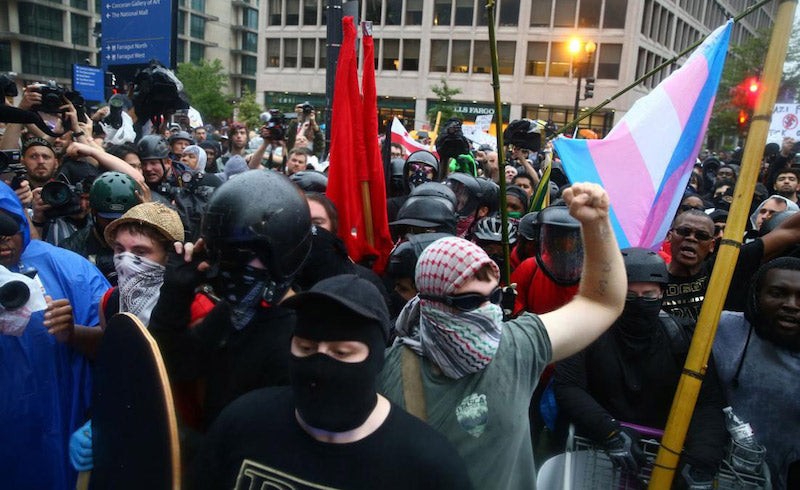
First published at From the River to the Sea.
In 1906 the Polish revolutionary Rosa Luxemburg published The Mass Strike, Party and Trade Unions.
The work emerged from a pamphlet Luxemburg had been commissioned to write by the Hamburg chapter of the German Social Democratic Party, or SPD. The pamphlet was meant to address a general question, or crisis, on the German socialist left: was capitalism reformable, capable of being transformed through gradual revision, including legislative, or must it be replaced outright in order for workers to achieve what Marx had called “self-emancipation.” For one faction of the SPD the answer was yes. For another, no.
Luxemburg initially thought to resolve the question by examining the role of strikes in socialist movements. Fortuitously, in 1905, her work was interrupted by the first attempt at revolution in Russia. After a government massacre of workers in St. Petersburg, a mass general strike erupted, welding political and economic demands, and quickly spread across other parts of the country. By October, a general strike forced the Tsar to promise political reform.
From the Russian example, Luxemburg concluded that the mass strike held a key to achieving Marx’s vision of a new workers’ society. As she characterized it in The Mass Strike:
It [the mass strike] is the living pulse-beat of the revolution and at the same time its most powerful driving wheel. In a word, the mass strike, as shown to us in the Russian Revolution, is not a crafty method discovered by subtle reasoning for the purpose of making the proletarian struggle more effective, but the method of motion of the proletarian mass, the phenomenal form of the proletarian struggle in the revolution.
Luxemburg’s document counterposed bureacratic gradualism and reformism with an essential confidence drawn from Marx that revolutions are the "locomotive" of history — its "method of motion" — and ordinary people its engineers. As she put it elsewhere in The Mass Strike, "the proletariat requires a high degree of political education, of class-consciousness and organisation. All these conditions cannot be fulfilled by pamphlets and leaflets, but only by the living political school, by the fight and in the fight, in the continuous course of the revolution."
Last Spring, although not (yet!) a mass strike in the manner of 1905, the strike form as “living political school” was revived in the US by school teachers. In West Virginia, 34,000 K–12 educators broke from their Union leadership, defied statewide right-to-work laws making strikes illegal, and shut down every school across the state by taking their grievances and demands to the streets. Their actions were soon replicated by teachers in Oklahoma, Arizona, Colorado, Kentucky, and North Carolina. In each instance, teachers self-organized, often in defiance of bureaucratic union leaders and state officials, walk-outs, walk-ins, occupations of government buildings, shutdowns of schools, picket lines, and marches that stretched as far as the eye can see.
The strikes were a reminder, to use Luxemburg’s formulation, that political advances of the oppressed are best developed “by the fight and in the fight.” This lesson bears deep consideration in a historical moment fraught with contradictions not unlike those that inspired Luxemburg’s pamphlet. Neoliberalism in general, and the 2007-2008 global economic crisis specifically, have reanimated powerful reformist ideas, and political organizations generally committed to them. From Syriza in Greece, to Podemos in Spain, to Jeremy Corbyn’s Labor Party in the UK, to the rise of the Democratic Socialists of America in the US, the promise of reformist social democracy as a better version of the world we have has taken deep root. We are living in an era where political organizations have emerged or reorganized, as Tithi Bhattacharya has noted, to “Make Reformism Great Again.”
Undoubtedly this is exciting news for revolutionaries as there are many things to be grateful for in this moment: Socialism in the United States as an idea has been recovered from the Cold War dustbin. Americans under 30 especially weight capitalism and socialism nearly equally as systems under which they’d like to live. The Democratic Socialists of America, now 45,000 strong — the largest Socialist organization in the United States in since the 1930s — have impressed themselves on the system in multitudinous ways: fighting for living wages, rent controls, Boycott, Divestment, Sanctions against Israel, Medicare for all. The DSA’s electoral breakthroughs since the Sanders campaign have served as earthquakes on a predatory political American landscape.
This reformist current co-exists with and is co-constituted by independent movements like Occupy and Black Lives Matter, which in different ways have brought sharp challenges to party-based politics and reformist models. Occupy’s language of the “1 percent” versus the rest posed a model of redistribution through independent popular revolt. Black Lives Matter, and the Movement for Black Lives Platform that followed it, argued for mass-based political action from below. By remaining largely independent of the major political parties, and attempting to use the street as a vehicle and theater of protest, BLM sought to make self-education and self-emancipation central tenets of redistributive political life.
Currently, the Palestinian liberation movement faces a serious challenge regarding the limits of reformist politics. The Boycott, Divestment, Sanctions Movement in the US has since 2005 been the independent mass-face of Palestinian liberation both in this country and globally. While the movement has had endorsements from political parties and organizations (like the African National Congress) it has rarely attempted to enter parliamentary politics as a tool of systemic reform.
The recent victories in US elections of Rashida Tlaib and Alexandria Ocasio-Cortez have threatened to change that dynamic. Both won primaries with somewhat vague promises of commitment to Palestinian liberation, while espousing political views on Palestine that align with the Democratic Party that is their electoral home. They have raised hopes among some activists that the election of enough Palestinian-friendly representatives might finally curtail US support for the Israeli Occupation and setter-colonial state.
While optimism is important, too much of it would be a mistake. History has shown the Democratic Party to be a "graveyard of social movements" time and again. The fact that AOC claims allegiance to the Democratic Socialists of America also demonstrates an unresolved variant of the “revisionist-revolutionist” divide within that large organization, what Kim Moody has called the “two souls” of democratic socialism.
That is why the Palestinian liberation movement needs to remain two-sided: only mass pressure from below — street protests like we saw in 2014 after Israel’s mass bombings of Gaza — can generate real challenge to the ossified, bureaucratic stranglehold of Israel’s settler-colonial apartheid state represented equally by the bereft Palestinian Authority in the West Bank, and the rabidly pro-Zionist Trump administration. Only large-scale protests and independent organizing, as for the BDS movement, can pressure elected officials to do the right things: refusing to vote for US military aid to Israel most important among them.
Indeed, the Palestinian movement might look to the teacher strike wave, Occupy, and Black Lives Matter to retain its spirited, wildcat independence from the two parties that have repeatedly voted to finance and support the immiseration of Palestinian people. The BDS movement should borrow a leaflet from The Mass Strike and make demands for Palestinian equality a platform in every labor movement, in every strike, in every workplace stoppage.
The Palestine movement might also look to the streets in the example of the U.S. antifascist movement.
Last Sunday, more than 4,000 people swamped the boulevards of Washington D.C. in response to a “Unite the Right” rally held in the shadow of the White House at Lafayette Park.
The counterdemonstration was organized by groups with a history of participation in independent mass struggles. They included Black Lives Matter DC, ANSWER Coalition, an anti-war, anti-racist group, and the International Socialist Organization. The on-the-ground coalition they assembled had the characteristics of a mass strike: a multiracial, largely working-class, immigrant, queer, trans, and straight contingent.
The protest was characterized as much by its diversity as by its discipline: organizers insisted that outnumbering the fascists was the first priority (they did, by nearly 200 to 1) and hewing to a single, united political goal of non-violent resistance to fascism. The march in turn generated what Luxemburg called “mental sediment.” Protestors walked the streets of Washington chanting slogans — “Black, Latino, Arab, Asian and White, Unite, Unite, Unite to Fight the Right” — that acquired meaning precisely through the motion of an action that included every one of those groups. The march burned away, at least momentarily, cynicism that often accrues in everyday life under capitalism, or among reformists who think a low ceiling is high enough, or in radical political sects who feel like the revolution can only pass through their door.
Indeed, in Washington, where I was one of the many thousands, people were so confident of their victory that they attempted to take ownership of the streets of D.C. Protestors trolled Baby Trump and the right-wing media, drowning out on-air reporters with chants of "Black Lives Matter." As we marched, people jumped on top of buildings to get a better look or fell in with us from the sidewalks. When we got to Lafayette Park and saw how total our victory was (the fascist "rally" looked like a tiny funeral across the pitch between us) the park became its own festival. Some people climbed trees. A gray-haired pair with tubas marched up and down. We taunted the fascists in song — "Hey Hey Hey, Goodbye." I saw one man with a parrot on his shoulder, people shouting "Ganamos" (We Won) in Spanish, and my favorite sign directed at the Nazis: "Your grandchildren will be mixed race." Then the rain came, the Fascists scurried off (their entire rally fit into two vans!) and we took over the streets again, singing "The Internationale" on an open boulevard.
These were not random acts of joy; they were collective expressions of victory generated by the recognition that we are many, they are few — one of the day’s chants — and that history is ours to make. More, they were articulations of massness realizing and achieving itself, an imaginary casting off of what Marx called the “muck of ages,” and a sedimented incarnation of the idea that another world is possible.
We do well to remember that one place still to win that world is in the streets.
Thanks to Tithi Bhattacharya for edits.
[book-strip index="1" style="display"]
